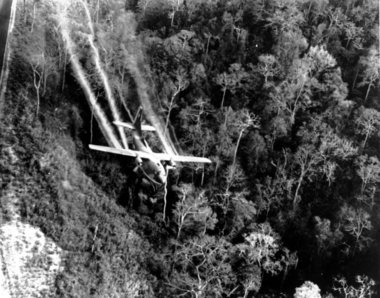This is first of six parts of the special report Unfinished Business: Suffering and sickness in the endless wake of Agent Orange.
By Connie Schultz, with photographs by Nick Ut

Fear of deformities from exposure to Agent Orange drives expectant mothers to storefront clinics like this one in downtown Hanoi, where many undergo multiple ultrasounds without doctors' referrals. Photo by Nick Ut, VRP
In late fall 2010, I was beginning a four-hour wait at Tokyo’s Narita International Airport for my flight to Hanoi when a Vietnamese woman sat down several rows away and offered a shy smile.
A few minutes later, she gathered up her carry-on bags and moved to the empty seat across from me.
She asked me a series of questions in English.
“You are from America?”
I nodded, and introduced myself. Returning the favor, she told me her name was Mui Nguyen.
“You are going to Vietnam?”
I nodded again.
“Why are you going there?”
I told her I was a journalist and that I was reporting on how women and children continue to be affected by Agent Orange.
“Ah,” she said, nodding again. “Agent Orange. Yes. I understand.”
We continued to talk, and her story unfolded. A mother of two children, she had grown up in Vietnam but was living in Canada. We discovered we were born in the same year, but the similarity in our childhoods ended there.
With little prodding, she recounted her first memory of the Vietnam War.
“When I was 8, I looked out the window of my bedroom in Hanoi and saw bombs falling from the sky,” she said. “After that first attack, we had to leave our home. We ran to the countryside. Every time the bombs fell, we ran into underground tunnels.”
She asked what I knew about Agent Orange. I recited the facts and figures and some of the stories of suffering that, by then, were keeping me up at night. Months of research had taught me what quantifiably happens when nearly 11.4 million gallons of herbicide containing the toxic chemical dioxin is dropped on a tiny, rural country — and never cleaned up.
Now I was on my way to meet the women and children behind those statistics.
Mui smiled, and sat a little higher in her seat.
“We love Americans,” she told me. “We hold no grudges. We understand you didn’t mean to hurt us like you did.”
By the time America’s war in Vietnam ended in 1975, more than 2.5 million Americans — including about 10,000 women — had served there; 58,148 died. Ohio ranked fifth among states in the number of losses.
Twenty-six of those soldiers came from my home county of Ashtabula. Until I went to college, I thought everyone knew someone who fought in Vietnam. That was the first time I realized some communities were hit harder than others. I have spent years trying not to think about that too much, because it sticks in that part of memory that has nothing to offer but pain.
What we resist persists, goes the adage. Last spring, Editor James Marcus of the Columbia Journalism Review sent an e-mail asking if I’d write an essay for the magazine’s “Second Read,” in which writers reflect on a formative work of journalism or nonfiction.
Only one book affected my life so deeply that I’d want to spend 3,400 words explaining why. Michael Herr’s “Dispatches” was a groundbreaking account of the Vietnam War from the perspective of the boys fighting it. I read it in 1978, when I was a sophomore at Kent State University.
I couldn’t write about the war without remembering my working-class hometown of Asthabula:
By the late 1960s, it seemed you couldn’t drive three blocks in any direction without passing the house of a boy who had gone to Vietnam. Neighbors would take over potluck and beer the night before they boarded the first flights of their lives. They left full of brag and bravado, but so many of them came home spent, and eerily old.
As the war progressed, our small town shifted incrementally, like a ship that slowly starts to tilt with an uneven load. First, we knew one boy who left. Then we knew another. Soon, Mom was writing notes to other mothers every week, it seemed, filling them with words of encouragement, or sympathy, in her careful backhand. I was in the middle phase of young life — too young to know everything, too old to know nothing at all. I would be sitting in school with 20 other fifth-graders, and suddenly a classmate would be called into the hall. The assumption was always that another family had gotten bad news from the war. One time it was our family, but the news was good after a really bad scare.
My cousin Norman was there and, for some reason, Mom knew there was a chance that he had been shot. I still remember the call that came two days later. I was sitting on the sofa when the phone rang and my mother rushed to answer. She listened for a few moments, and started to cry. “He’s alive!” she yelled, “He’s alive.” She later said his air mattress had been shot out from under him. I pictured him lying on one of those colorful inflated rafts swimmers used on Lake Erie, and thought Vietnam must be one crazy place.
Nearly 2.5 million Americans served in Vietnam. Ohio lost 3,094 of them. The rest of our boys came home, but the ship never righted. Guys I’d known my entire life weren’t fun, or funny, anymore. No more teasing, no big-brother reprimands to get out of the street and quit picking on the little ones. Sometimes I’d look at my friends’ older brothers sitting at the end of long front porches and their stares would scare me. I’d look in their eyes and get goose bumps. It was as if they thought I was trying to start a fight just by smiling at them. I’d scamper off, full of questions my father warned me never to ask.
Thirty-five years later, the country of Vietnam remained a gnawing mystery for me, as it does for so many Americans of my generation. But the swirl of my interest began and ended with the stories of the American lives that were changed and sacrificed. I spent little time thinking about how the war had affected those who continue to live in Vietnam. Instead, I broke down the issue in a way that avoids all complexity, or reflection: The Vietnamese were the victors, and we were the victims of an ill-conceived “conflict” that was never resolved.
I knew a few America-centric details about postwar Vietnam: After the collapse of Saigon in 1975, the U.S. enforced a trade embargo that was not lifted until February 1994. Three years later, President Bill Clinton appointed former POW and U.S. Rep. Douglas “Pete” Peterson as the first U.S. ambassador to Vietnam. Since 1973, Vietnam has identified the remains of 627 of 1,353 missing Americans. Today, 726 American servicemen have yet to be found.
That was about all I knew about postwar Vietnam.
What I should have known about our unfinished business there is the rest of this story.

uring the Vietnam War, the U.S. military sprayed 11.4 million gallons of an herbicide called Agent Orange, which contained the toxic chemical dioxin. Today, 28 dioxin "hot spots" continue to damage Vietnam's food supplies and imperil the health of its citizens. AP File photo
The U.S. military mission was to obliterate the canopied jungles and forests of South Vietnam that provided impenetrable coverage for Ho Chi Minh’s North Vietnamese Army.
Between 1962 and 1971, at airports and American operations centers throughout South Vietnam, the U.S. military stored, mixed, handled and loaded onto airplanes more than 20 million gallons of herbicide.
The spraying campaign ravaged 5 million acres of jungle and forest, and destroyed crops on another 500,000. Various chemical companies, including Dow, Monsanto, Diamond Shamrock, Occidental and Hercules, supplied the herbicides. Early on, U.S. planes dropped pamphlets written in Vietnamese, assuring farmers that the chemicals were harmless to humans and animals.
Some of the herbicides, named for the color of the stripe on their barrels, were contaminated with dioxin. Agent Purple, Agent Pink, Agent Green. The most toxic of these brews was Agent Orange.
Today, more than 2 million acres in Vietnam remain barren. Numerous studies have shown that “hot spots” on the perimeter of former U.S. bases in the south still leach dioxin into the soil, contaminating water, vegetation, wildlife — and people. Field researchers have found dioxin in nursing mothers’ milk and bloodstream, at far greater than established safe levels.
The Vietnam War ended but a silent threat from Agent Orange remained, Page 2
Unfinished Business: Suffering and sickness in the endless wake of Agent Orange






